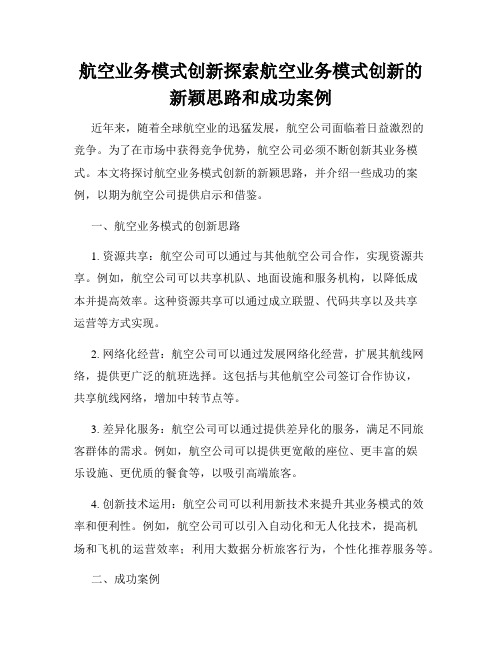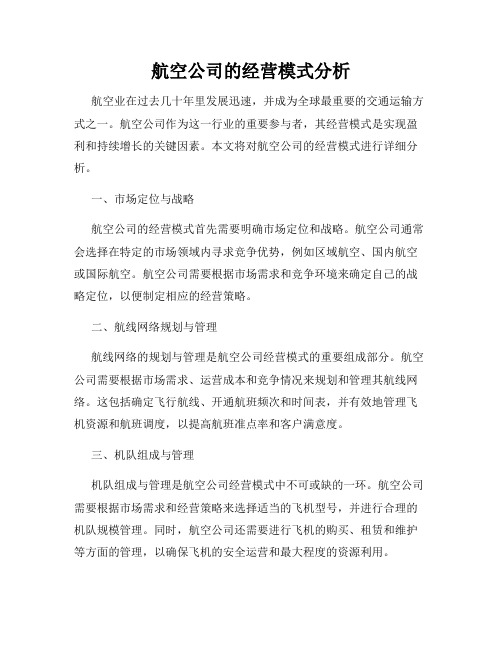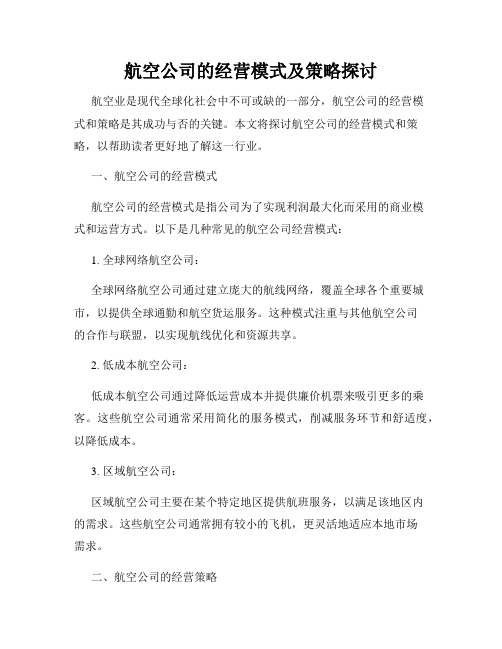航空公司运营模式的变革
航空业务模式创新探索航空业务模式创新的新颖思路和成功案例

航空业务模式创新探索航空业务模式创新的新颖思路和成功案例近年来,随着全球航空业的迅猛发展,航空公司面临着日益激烈的竞争。
为了在市场中获得竞争优势,航空公司必须不断创新其业务模式。
本文将探讨航空业务模式创新的新颖思路,并介绍一些成功的案例,以期为航空公司提供启示和借鉴。
一、航空业务模式的创新思路1. 资源共享:航空公司可以通过与其他航空公司合作,实现资源共享。
例如,航空公司可以共享机队、地面设施和服务机构,以降低成本并提高效率。
这种资源共享可以通过成立联盟、代码共享以及共享运营等方式实现。
2. 网络化经营:航空公司可以通过发展网络化经营,扩展其航线网络,提供更广泛的航班选择。
这包括与其他航空公司签订合作协议,共享航线网络,增加中转节点等。
3. 差异化服务:航空公司可以通过提供差异化的服务,满足不同旅客群体的需求。
例如,航空公司可以提供更宽敞的座位、更丰富的娱乐设施、更优质的餐食等,以吸引高端旅客。
4. 创新技术运用:航空公司可以利用新技术来提升其业务模式的效率和便利性。
例如,航空公司可以引入自动化和无人化技术,提高机场和飞机的运营效率;利用大数据分析旅客行为,个性化推荐服务等。
二、成功案例1. 资源共享的案例 - 星空联盟星空联盟是一个由航空公司组成的全球性联盟,旨在实现成员航空公司之间的资源共享。
该联盟的成员航空公司可以共享机队、航班网络、客户积分等资源,与其他航空公司合作开发新航线。
通过星空联盟,旅客可以在不同的航空公司之间使用同一张机票,提供了更多便捷的旅行选择。
2. 网络化经营的案例 - 寰宇一家寰宇一家是中国的一家综合型航空公司,拥有庞大的航线网络和多家子公司。
寰宇一家通过与其他航空公司签订代码共享协议,并增加中转节点,扩展了其航线网络。
这使得旅客可以通过寰宇一家航空公司方便地实现多地中转,并享受到更多的航班选择。
3. 差异化服务的案例 - 起航航空起航航空是一家以服务体验为核心的低成本航空公司。
航空公司的经营模式分析

航空公司的经营模式分析航空业在过去几十年里发展迅速,并成为全球最重要的交通运输方式之一。
航空公司作为这一行业的重要参与者,其经营模式是实现盈利和持续增长的关键因素。
本文将对航空公司的经营模式进行详细分析。
一、市场定位与战略航空公司的经营模式首先需要明确市场定位和战略。
航空公司通常会选择在特定的市场领域内寻求竞争优势,例如区域航空、国内航空或国际航空。
航空公司需要根据市场需求和竞争环境来确定自己的战略定位,以便制定相应的经营策略。
二、航线网络规划与管理航线网络的规划与管理是航空公司经营模式的重要组成部分。
航空公司需要根据市场需求、运营成本和竞争情况来规划和管理其航线网络。
这包括确定飞行航线、开通航班频次和时间表,并有效地管理飞机资源和航班调度,以提高航班准点率和客户满意度。
三、机队组成与管理机队组成与管理是航空公司经营模式中不可或缺的一环。
航空公司需要根据市场需求和经营策略来选择适当的飞机型号,并进行合理的机队规模管理。
同时,航空公司还需要进行飞机的购买、租赁和维护等方面的管理,以确保飞机的安全运营和最大程度的资源利用。
四、票价制定与收益管理票价制定和收益管理是航空公司经营模式中的核心因素。
航空公司需要根据市场需求、竞争情况、成本结构和目标盈利等因素来制定适当的票价策略。
同时,航空公司还需要通过收益管理技术来最大化收入,例如根据需求变化来灵活调整票价、优化座位分配和制定销售促销策略等。
五、客户服务与满意度客户服务和满意度是航空公司经营模式中的重要方面。
航空公司需要提供高质量的客户服务,包括舒适的机舱环境、友好的机组人员、准时的航班和高效的行李处理等。
同时,航空公司还需要通过客户反馈和调研等方式来不断改进服务质量,提高客户满意度和忠诚度。
六、成本管理与效率提升成本管理和效率提升是航空公司经营模式中的关键环节。
航空公司需要通过精细的成本控制和管理来提高运营效率和盈利能力。
例如,通过优化机组和员工的规模与结构、减少燃油消耗、提高飞机使用率和改进供应链管理等方式来降低成本并提高效率。
航空公司的运营管理如何优化航空公司的运营效率

航空公司的运营管理如何优化航空公司的运营效率航空业作为现代化交通工具的重要组成部分,扮演着连接世界的重要角色。
为提高航空公司的运营效率,提供更好的服务质量和客户体验,以下是一些优化航空公司运营管理的建议。
1. 优化航班调度和航线规划航班调度和航线规划是航空公司运营的核心。
为了有效利用航班资源,航空公司应采用现代化的航班调度系统,并运用数据分析技术和预测模型来确定最佳航线和航班频率。
通过充分利用高效的航线,航空公司可以有效减少航班延误和取消,提高整体运营效率。
2. 优化机队管理机队是航空公司运营的重要资产,因此良好的机队管理对提高运营效率至关重要。
航空公司可以采用先进的飞机维修和保养计划,确保飞机在最佳状态下运营。
此外,合理安排飞机的使用和调配,以最大程度地减少飞机的停飞时间,并通过技术创新,提高航空器的燃油效率,减少运营成本。
3. 强化航空安全管理航空安全是航空公司应当高度关注的重要问题。
为了保障航空旅客的生命安全和财产安全,航空公司应制定严格的安全管理制度和流程,并不断加强飞行员和机组人员的培训和素质提升。
同时,航空公司还应加强与各个相关部门的合作,共同应对各类突发事件和安全威胁,确保安全运营和顺畅服务。
4. 提升客户服务和体验航空公司的运营效率不仅体现在航班的准点率和运力利用率上,也体现在客户服务和体验方面。
航空公司可以通过优化自动售票系统,提供在线值机和行李跟踪服务,以及实时更新航班信息和机上娱乐设施等方式,更好地满足乘客的需求,并提供舒适愉快的飞行体验。
5. 加强供应链管理航空公司的供应链管理直接关系到公司的运营效率和服务质量。
航空公司应与供应商建立良好的合作关系,并通过合理的库存管理和物流流程优化,确保航空燃油、餐饮、维修设备等关键物资的供应充足,减少运营中的不必要延误和停工。
6. 运用大数据分析和人工智能技术随着信息技术的迅速发展,航空公司可以通过运用大数据分析和人工智能技术来优化运营管理。
航空公司优秀论文

航空公司优秀论文航空运输业作为一个重要产业,对国家经济增长具有重大影响,而中国航空运输业的发展更具有巨大潜力。
下文是店铺为大家整理的关于航空公司优秀论文的范文,欢迎大家阅读参考!航空公司优秀论文篇1浅析建设低成本航空公司的可行性摘要:随着我国成为全球第二大经济体,民间贸易、旅游、公务等经济活动越来越频繁,我国只有让民航运输成为百姓出行的一个可以接受的选择,才能真正走近普通百姓,我国才能真正实现从民航大国向民航强国的转变。
本文就如何发展低成本航空公司进行了论述。
关键词:民航运输低成本航空公司促进消费分析随着我国经济的不断发展,人民生活水平的不断提高,民航运输以其高舒适性,高安全性,快速便捷等特点而受到越来越多人的青睐。
而且新增的旅客中以因私旅行者居多,他们对票价有着较强的需求弹性。
据调查显示,在因私旅行的人群中,大多数人愿意乘坐低票价的飞机出行。
面对人口众多和经济欠发达等现状,我国旅客对低成本、低票价的航空服务有着更强烈的需求。
1.什么是低成本航空公司低成本航空公司,也叫廉价航空公司,即低票价、低成本、简化服务的航空公司。
低票价即任意一家航空公司应在全部销售的票价中有70%的票价是低水平的,而不是只有10%的起到广告效应的低票价。
自9.11事件之后,低成本航空公司发展迅速,低成本浪潮从美国开始掀起并迅速席卷欧洲,亚洲一些国家也出现了低成本航空公司并获得了较大发展。
2005年4月泰国的亚洲航空公司首次进入中国,网上订票从厦门至曼谷单程票价仅为99元(USD12)。
国外低成本航空公司正式拉开了抢滩中国民航低端市场的序幕。
但是我国廉价航空一直未能得到应有的重视。
春秋航空在2005年7月首航的时候,虽然打出了廉价航空牌,其上海到烟台的199元的超低价机票更是给予了人们无限的遐想。
人们期待在“鲇鱼效应”下,一直高高在上的机票价格,能够就此走下高台。
遗憾的是,此超低价票还不到该次航班机票的十分之一,“廉价航空”的口号只不过是其促销手段而已。
航空行业数字化化转型的实践和思考

航空行业数字化化转型的实践和思考现代航空业是一个复杂的系统,包括航班计划、客户服务、航班运营、安全管理等多个领域。
对于航空公司而言,如何提高运营效率,提升客户体验并确保安全运营是每个航空公司面临的重要问题。
随着数字技术的快速发展,数字化转型已成为航空业转型发展的重要趋势。
本文将从数字化转型的背景、数字化转型的实践和数字化转型的思考三部分对航空行业数字化转型进行描绘和分析。
1. 数字化转型背景数字化转型是信息技术带来的又一个重大革命,也是企业提高效率、创新商业模式、辐射全球市场的重要途径。
数字化转型对航空行业带来了极大的变革。
数字化转型在航空行业中主要表现在以下四个方面:1.1 机载无线网络在数字化转型的推进下,航空公司逐渐实现了机载无线网络的普及。
在过去,无线网络在航空业中只是一种奢侈品,但现在,随着科技的不断发展,机载无线网络逐渐成为基本设施的一部分,为乘客提供了更好的舱内服务体验。
1.2 人工智能技术的应用人工智能技术的应用在航空行业中也变的越来越重要。
在现代航空公司中,人工智能技术已经被应用在行李追踪、飞行控制以及客户服务等多个领域。
在人工智能技术的支持下,航空公司可以更好的处理客户反馈,指导机上服务及修理等相关工作,提高效率吸引更多的乘客。
1.3 数据分析数字化转型的应用还体现在数据分析中,数据分析对航空公司和乘客都十分重要。
数据分析的应用可以帮助航空公司更好地评估飞机维护区间和与整个飞行计划相关的风险,同时也为乘客提供了更好的旅行建议。
数据分析的应用也使得航空公司们能够更好地进行市场战略和分析,从而更加准确的了解旅客需求。
1.4 区块链技术的应用区块链是一种数字化转型和技术革命的重要表现形式,区块链可以帮助航空公司提高航班安全,提高航班数据可靠性,同时还可以为乘客提供更加透明的数据展示,提高企业信任度,增强品牌形象。
2. 数字化转型的实践数字化转型是航空公司实现转型的重要手段,在航空公司的实践中,数字化转型主要体现在以下三个方面:2.1 数据驱动航班运营数据驱动航班运营不仅可以帮助航空公司提高运营效率,降低成本,提高安全管理水平,还可以为乘客提供更加便利快捷的服务。
航空公司的经营模式及策略探讨

航空公司的经营模式及策略探讨航空业是现代全球化社会中不可或缺的一部分,航空公司的经营模式和策略是其成功与否的关键。
本文将探讨航空公司的经营模式和策略,以帮助读者更好地了解这一行业。
一、航空公司的经营模式航空公司的经营模式是指公司为了实现利润最大化而采用的商业模式和运营方式。
以下是几种常见的航空公司经营模式:1. 全球网络航空公司:全球网络航空公司通过建立庞大的航线网络,覆盖全球各个重要城市,以提供全球通勤和航空货运服务。
这种模式注重与其他航空公司的合作与联盟,以实现航线优化和资源共享。
2. 低成本航空公司:低成本航空公司通过降低运营成本并提供廉价机票来吸引更多的乘客。
这些航空公司通常采用简化的服务模式,削减服务环节和舒适度,以降低成本。
3. 区域航空公司:区域航空公司主要在某个特定地区提供航班服务,以满足该地区内的需求。
这些航空公司通常拥有较小的飞机,更灵活地适应本地市场需求。
二、航空公司的经营策略为了在竞争激烈的航空市场中生存和发展,航空公司需要制定有效的经营策略。
以下是一些常见的航空公司经营策略:1. 价格策略:航空公司可以通过灵活的定价策略来吸引乘客。
他们可以根据季节性需求变化、航班时间和座位预订情况等因素来调整票价,以最大限度地提高座位利用率和收益。
2. 客户服务:航空公司通过提供卓越的客户服务来赢得乘客的忠诚度。
这包括友好的机组服务、便捷的在线预订系统、舒适的机舱环境等。
与此同时,航空公司还致力于处理客户投诉和退款事宜,以保持良好的声誉。
3. 航线网络优化:航空公司需要不断优化其航线网络,以满足乘客需求和提高利润。
他们可以选择开通新航线,取消亏损的航线,并在不同航线之间进行飞机资源调配。
4. 机队更新:航空公司需要定期更新和维护飞机机队,以保持飞行安全和效率。
他们可以采购新一代节能型飞机,减少燃料成本,并降低对环境的影响。
5. 营销与推广:航空公司通过广告和宣传活动来提升品牌知名度和市场份额。
国内传统货航的转型和发展之路
国内传统货航的转型和发展之路1. 引言1.1 国内传统货航的转型和发展之路国内传统货航一直是中国航空运输行业中的重要组成部分,但随着市场需求和科技发展的变化,传统货航面临着转型和发展的挑战。
在全球贸易不断加速的背景下,中国作为世界上最大的货物生产和消费国之一,货航行业的发展至关重要。
随着电商的兴起和消费升级,货运需求呈现出多样化和个性化的趋势,传统货航在满足市场需求方面面临着一定的压力。
传统货航的运营模式和服务水平也面临着提升的需求,需要借助数字化技术和新能源技术来提升效率和降低成本。
为了适应市场的变化和提升竞争力,航空公司需要制定有效的转型策略,注重货航服务的全面升级,提高运输效率和服务质量。
环保和新能源技术的应用也是货航行业转型的重要方向,通过降低排放和提高能源利用效率来实现可持续发展。
在国内传统货航的转型和发展之路上,虽然取得了一些初步成果,但仍面临着诸多挑战。
展望未来,国内货航有着广阔的发展空间和美好的发展前景,需要在政策支持、技术创新和人才培养等方面持续努力,实现行业的可持续发展和繁荣。
2. 正文2.1 传统货航的现状和挑战传统货航作为国内货运领域的重要组成部分,一直扮演着连接各个城市和地区的重要角色。
随着时代的发展和市场的竞争日益激烈,传统货航也面临着一些现状和挑战。
传统货航在航线布局上存在不合理的问题。
由于很多航空公司在过去主要关注客运业务,对于货运的布局并不完善,导致一些地区的货运需求无法得到有效满足。
这样就造成了一些地区货运运力不足、运价偏高的问题。
传统货航在信息化程度上存在不足。
很多航空公司在管理和运营过程中还停留在传统的模式,缺乏现代化的信息化技术支持,导致运营效率不高、服务质量有待提升。
传统货航在服务品质和时效性方面也存在一些问题。
虽然货航的主要优势是速度快、运力大,但是在服务品质、时效性等方面还有较大的提升空间。
客户对于货运的要求越来越高,希望在保证速度的能够得到更为细致周到的服务。
低碳经济下航空公司运营模式的改变
低碳经济下航空公司运营模式的改变[摘要]随着温室气体的排放,它的影响越来越严重。
低碳经济模式应该成为人类可持续发展的选择。
本文将分析在低碳经济背景下,航空公司在低碳经济背景下可持续发展的重要性和其基本特征以及对航空公司的影响。
这表明,为了可持续发展,航空公司应该系统地革新管理并且在低碳经济背景下走特色化运营的路。
[关键词]低碳经济航空业产业集群随着时代的发展,能源匮乏的问题愈演愈烈,“低碳经济“的产生对这一问题起到了一定的缓冲作用。
“低碳经济”是指摒弃20世纪传统增长模式,直接应用新世纪的创新技术与创新机制,通过低碳经济模式与低碳生活方式,实现社会可持续发展。
近年来“低碳革命”对全球航空业格局造成巨大冲击,给我国航空业发展带来空前压力。
高能源消耗导致环境受到污染。
航空公司在运营体系方面同样也要实施“低碳运营模式”,更是要建立一个“低消耗、低污染、高产出”的n型经济模式。
近年来欧美航空提出“绿色航空”这一思想,他们不仅在航空公司的运营模式上加大改进力度,更是从飞机的外观设计,能源使用方面,不惜重金也要改进技术,做到“绿色航空”,更得到了广大航空业内人士的关注。
一、航空公司传统运营模式随着航空业的不断发展,航空公司的运营模式也在不断的改变,田琳,翁亮和孙秀丽(2008)在《我国航空公司资本运营模式浅析》中提出:世界经济发展出现了新的趋势,资本运营的浪潮在世界范围内普遍兴起。
资本运营作为一种与市场经济相适应的管理理念,对我国的企业改革有特殊的意义,它是企业发展壮大的必由之路。
而资本运营是航空公司实现这一目标的不可或缺的工具之一,是企业创造财富的魔方。
从以上两张图中可以看出,鉴于航空服务的特征,传统型航空公司依赖于其网络力量和产品差异化策略从而获得较高的收益,在某些情况下可以弥补其成本高昂的不利劣势。
特别是他们全力以赴提升公务和头等舱的服务,毕竟这是他们收入的主要来源。
现在,低成本航空公司通过特色产品和服务在一些主干线上已经直接和传统型航空公司竞争,目标就是争夺收益更高的公务和商务客源,但我们在关系图中不难看出,在一层层的关系网中,有很多都要通过纸质化办公,这不仅有违了低碳的理念,也浪费了企业的资源,造成了成本的负担。
航空运输的发展趋势是什么
航空运输的发展趋势是什么航空运输作为现代交通运输体系中的重要组成部分,在全球经济和社会发展中发挥着日益关键的作用。
随着科技的不断进步、市场需求的变化以及环保意识的增强,航空运输正面临着一系列新的挑战和机遇,其发展趋势也呈现出多元化和创新性的特点。
一、技术创新引领航空运输的变革1、飞机制造技术的突破新一代飞机的研发正朝着更高效、更环保、更舒适的方向发展。
复合材料的广泛应用使得飞机结构更轻更强,从而降低了燃油消耗。
例如,波音 787 和空客 A350 大量采用复合材料,显著提高了飞机的性能。
此外,先进的空气动力学设计和发动机技术不断提升燃油效率,减少碳排放。
未来,电动飞机和混合动力飞机的研发有望取得重大突破,为航空运输带来革命性的变化。
2、航空电子技术的进步先进的航空电子系统使飞行更加安全和智能化。
自动驾驶技术的不断完善,不仅减轻了飞行员的工作负担,还提高了飞行的准确性和稳定性。
同时,智能导航系统能够根据实时气象和交通状况优化航线,减少飞行时间和燃油消耗。
另外,飞机上的通信技术也在不断升级,乘客可以在飞行中享受高速稳定的网络连接,提升出行体验。
3、机场设施的智能化智能化的机场设施是提高航空运输效率的关键。
自助值机、自助行李托运和智能安检系统的广泛应用,大大缩短了旅客办理登机手续的时间。
机场跑道和停机坪的智能监控系统能够实时监测设备状态和运行情况,提高机场的运营效率和安全性。
此外,智能物流系统能够实现行李和货物的快速准确分拣和运输,提高货物运输的效率和准确性。
二、市场需求推动航空运输的多元化发展1、低成本航空的持续增长随着人们出行需求的不断增加,低成本航空在全球范围内迅速崛起。
低成本航空公司通过简化服务、优化运营流程和采用单一机型等方式降低成本,为旅客提供更加实惠的机票价格。
未来,低成本航空将继续扩大市场份额,尤其在中短途航线市场上表现强劲。
同时,低成本航空也在不断提升服务质量,以满足旅客日益多样化的需求。
我国航空体制的变革
我国航空体制的变革我国航空体制的变革随着改革开放的不断深化和市场经济的发展,我国航空业经历了翻天覆地的变化。
从过去仅仅依靠国有航空公司运行的单一航空体制,到如今多元化、开放的航空产业格局,我国航空体制的变革取得了重大突破和进展。
本文将围绕着我国航空体制的变革进行详细探讨。
首先,我国航空体制的变革始于上世纪80年代初。
当时,我国国有航空公司作为唯一运营主体,以运输机的形式承担了大部分国内外客货运输任务。
然而,随着市场经济的发展和航空运输需求的增加,单一航空体制面临着资源配置、效益提高等方面的制约。
于是,为了适应经济社会的发展需求,国家开始着手改革航空体制。
其次,我国航空体制的变革集中体现在体制机制创新方面。
改革开放以来,我国相继出台了一系列有利于航空企业发展的政策,如扩大民航市场的开放程度、鼓励航空公司参与国际合作等。
同时,航空公司也开始实施公司化管理制度,引入市场化的竞争机制。
这些改革举措有效推动了我国航空体制的变革,为航空产业的快速发展打下了坚实基础。
第三,我国航空体制的变革还体现在航空公司运营模式的转变上。
改革开放以前,我国的航空公司基本上只从事运输机的运营,过于依赖国内市场。
而在改革后,航空公司开始逐渐拓展业务范围,增加了多种经营形式,如航空公司与机场、旅行社等合作,开展多元化的航空服务。
此外,我国也引入了国际通用的航空运输网络和运营模式,促进了我国航空公司与国际航空公司的合作与交流。
第四,我国航空体制的变革还反映在航空技术与装备的创新上。
改革开放以来,我国逐渐掌握了飞机设计、制造、维修等核心技术,推动了航空技术的发展和航空装备的升级。
例如,我国成功自主研制了运十飞机、国产大型客机C919等,成为国际航空市场的重要参与者。
同时,航空电子、航空通信、导航等领域也取得了长足进展,为我国航空业的快速发展提供了坚实支撑。
最后,我国航空体制的变革还受益于国家政府的支持和引导。
改革开放以来,航空业成为国家重点发展的战略性产业。
- 1、下载文档前请自行甄别文档内容的完整性,平台不提供额外的编辑、内容补充、找答案等附加服务。
- 2、"仅部分预览"的文档,不可在线预览部分如存在完整性等问题,可反馈申请退款(可完整预览的文档不适用该条件!)。
- 3、如文档侵犯您的权益,请联系客服反馈,我们会尽快为您处理(人工客服工作时间:9:00-18:30)。
EXECUTIVE INSIGHTS VOLUME XVI, ISSUE 34 Aviation Isights Review (AIR): The Future of Airline Business Models – Which Will Win? was written by John Thomas, a managing director in L.E.K. Consulting’s Boston office, and Brett Catlin, an engagement manager in L.E.K. Consulting’s Boston office. For more information contact aviation@.It’s been more than three decades since U.S. deregulationspurred the first crop of airline business model innovations. Asmarkets liberalized across the globe, industry reformers searchedfor sustainable competitive advantage across dozens of differentmodels covering the spectrum of service level, aircraft gauge,geography, frequency and, of course, price.Aviation Insights Review (AIR):The Future of Airline Business Models – Which Will Win?Through the 2000s, the net result of this business modelexperimentation was a clear competitive dichotomy betweentraditional full-service carriers (FSCs) and upstart low-cost carriers(LCCs). This dynamic is quickly changing as LCCs come of age,FSCs restructure and the broader market landscape forces newthinking on how to deliver differentiated value.Figure 1Three Primary Models Shape Airline’s Strategic DirectionPriceFocusULTRALow Cost Carrier• Fully unbundled(e.g., charge for carry-ons)Low Cost CarrierLow CostCarrierPREMIUMFull Service Carrier• Enhanced services (e.g., Y/W)• Low fare positioning• Multiple cabins (e.g.,Y/W/J/F)• High-end features (e.g., lie-flats)Full ServiceCarrierExperienceFocusGrowing Presence of Hybrids Across RegionsOn a regional basis, the steady ascent of hybrid carriers is evident across virtually all geographies with the model already commanding roughly 20–40% market share (less Africa). With the exception of North America, the expanding hybrid carrier model is expected to endure as a strong value proposition continues to resonate with consumers in both developed and emerging markets. The ULCC growth story is more mixed as regulatory hurdles, infrastructure constraints and entrenched labor interests challenge the ultra-low-cost premise in underpenetrated markets including Africa, the Middle East and Latin America. Across the liberalizing/liberalized markets of Asia and North America, L.E.K. expects ULCCs to post sustained growth for the foreseeable future as penetration ultimately approaches the now-saturated levels seen in Europe (see Figure 4).This global dynamic and the associated regional variations present both critical long-term strategic questions and short-term tactical opportunities (and potential challenges) for carriers across the continuum.Next Steps: What to ConsiderAs executives work to optimize their operating models, it is incumbent on all carriers to sharpen their strategic focus on delivering a clear customer value proposition in order to maintain relevance in an increasingly competitive global environment. For each of the observed business models, L.E.K. offers key considerations for moving forward.Realignment of Airline Business ModelsAgainst this backdrop, L.E.K. observes a market that has steadilygiven way to coalescence around three primary business models (see Figure 1).For carriers that have pioneered or actively transitioned to one of the three observed models, there is almost always a clear customer value proposition and supporting brand ethos. For ultra-low-cost carriers (ULCCs), it’s a relentless focus on stimulating new demand with low fares (“Now Everyone Can Fly”). In the case of hybrids, it’s a value-centric appeal with a service orientation (“You Above All”). The premium full-service carrier (PFSC) proposition increasingly emphasizes and differentiates around the holistic passenger experience (“A Great Way to Fly”). To remain competitive over the long term, carriers employing either a traditional LCC model or legacy FSC operation are at a strategic crossroads. In many cases, the choice is to reinvent themselves as hybrid carriers or to implement large-scale changes aimed at dramatically reducing base fares or to double down on experiential enhancements.While champions have emerged for each business model, the superior aggregate financial performance of ULCC and hybrid carriers has enabled these operators to flourish in a market where legacy FSCs have historically dominated (see Figure 2). As a result, ULCCs and hybrids have grown from 18% of global traffic in 2003 to over 34% today. Looking out a decade, L.E.K. projects this share will increase to 43%, with ULCCs and hybrids registering nearly double the annual growth rate of premium carriers (see Figure 3).Figure 2Economic Profit by Carrier Business Model (2008-2013)20th to 80th EP Percentile-8-7-6-5-4-3-2-1012345678Note: L.E.K. broadly defines economic profit as the surplus the company generates after charging for the capital that it employs at its relevant cost of capital rate.PFSC: -7.1% to 0.2%HYBRID: -3.2% to 6.0%ULCC:5.7%to 7.6%Figure 3Top 150 Carrier Capacity by Carrier Type (2004 – 2023)123456 2.520042014202365%75%88%PFSC ASK Share (%)4.0 6.013%30%57%11%23%66%4%14%82%N u m b e r o f s e a t s (i n b i l l i o n s )ULCC HYBRID PFSCUltra-Low-Cost Carriers: Delivering on the Lowest Fare PromiseThe rise of the ULCC model has rapidly moved from Europe to Australia to North America and Asia. As existing carriers lookto sustain rapid expansion and new carriers aim to enter highly competitive markets, there are a number of potential strategies to continue delivering on the lowest fare promise:Tactical opportunities:• E mbrace mobile technology and self-service options to streamline the end-to-end experience• I ntroduce a for-fee “club” in lieu of a traditional loyalty program• S olve the ULCC network paradox (e.g., charge a fee to interline)• R einvent ancillaries with variable pricing and value-added bundles• I mprove monetization of the captive customer baseStrategic questions:• H ow do you maintain a best-in-class cost position in an industry that is notorious for cost escalation?• H ow do you attract and meet the needs of price-conscious small and medium enterprises without radically changingthe business model?• W hat is the truly addressable market for ULCCs in terms of length of haul?• H ow do you create win-win partnerships with hybrids and premium carriers?Hybrid Carriers: Generating Differentiated V alueDelivering a strong customer value proposition has enabled hybrid carriers to thrive across a number of global markets. From Brazil to the United States, Australia and Singapore, there has consistently been demand for carriers that offer low fares and a quality service proposition. As hybrids move into the mainstream in many markets, there are a number of step-out opportunities to continue delivering a compelling value proposition:Tactical opportunities:• B uild a virtual network of strategically aligned partners in lieu of traditional alliance membership• D evelop pioneering product solutions (e.g., seating, entertainment, ground services, etc.)• I ntroduce a rewarding (and differentiated) loyalty scheme for both individuals and small/medium enterprises• I nvestigate unique distribution strategies and revenue management policiesStrategic questions:• H ow do you continue to deliver superior value in a market with airlines flanked on both sides of your business model(lower cost; “better” experience)?• W hat is the strategy to expand the relevance of the platform without straying from the value proposition thatmakes the model successful?• H ow do you use customer segmentation to solidify your value proposition?Premium Carriers: Providing aSuperior Travel ExperienceWhile often lamented as “legacy” players, a number of global premium carriers are on the rebound with intriguing propositionsFigure 4Regional Business Model OutlookDecreased businessmodel share (2023)Increased businessmodel share (2023) NORTH AMERICAMIDDLE EASTLATIN AMERICAEUROPEAUSTRALASIAASIAAFRICAREGION4%31%65%1%19%80%0%42%58%25%20%56%18%23%58%7%17%75%3%12%85%ULCC HYBRID PFSC(10%)(5%)0%5%10%that effectively deliver value in even the most competitive markets. As premium carriers look to extend their position (or survive under siege) there is a broad range of opportunities to leverage their global platforms, including:Tactical opportunities:• P ursue innovative partnerships to add scale in key markets with non-traditional partners• T ake customer segmentation to a new level with personalization that solidifies the value proposition• E nhance the passenger experience through innovative ancillary options• Utilize the loyalty program as the “front door to the airline”• R ecognize and delight high-value flyers through technology-enabled experience tailoringStrategic questions:• W hat is the most effective method of competitionagainst the hybrid value proposition (e.g., fare brands, airline-within-an-airline, etc.)? Is the solution the same for short-, medium- and long-haul?• W hat are the unexploited opportunities to truly differentiatethe premium carrier model? How do you move beyond a largely commoditized economy product (and prevent the commoditization of the business product)?• I s there a way to fundamentally change the labor model?• T o increase differentiation with the hybrid model, do youneed to go further upmarket and if so, what are the most effective means to do so?• H ow do you truly “own” your customer’s overall travelexperience (and participate in a much bigger value pool) while maintaining your core brand proposition?L.E.K. Consulting is a registered trademark of L.E.K. Consulting LLC. All other products and brands mentioned in this document are properties of their respective owners.© 2014 L.E.K. Consulting LLCL.E.K. Consulting is a global managementconsulting firm that uses deep industry expertise and analytical rigor to help clients solve their most critical business problems. Founded more than 30 years ago, L.E.K. employs more than 1,000 professionals in 21 offices across the Americas, Asia-Pacific and Europe. L.E.K. advises and supports global companies that are leaders in their industries – including the largest private and public sector organizations, private equity firms and emerging entrepreneurial businesses. L.E.K. helps business leaders consistently make better decisions, deliver improved business performance and create greater shareholder returns.For further information contact:Los Angeles1100 Glendon Avenue 19th FloorLos Angeles, CA 90024 T elephone: 310.209.9800 Facsimile: 310.209.9125Boston75 State Street 19th FloorBoston, MA 02109Telephone: 617.951.9500 Facsimile: 617.951.9392ChicagoOne North Wacker Drive 39th FloorChicago, IL 60606T elephone: 312.913.6400 Facsimile: 312.782.4583New York1133 Sixth Avenue 29th FloorNew York, NY 10036 T elephone: 646.652.1900 Facsimile: 212.582.8505San Francisco100 Pine Street Suite 2000San Francisco, CA 94111 T elephone: 415.676.5500 Facsimile: 415.627.9071International Offices:Beijing Chennai London Melbourne Milan Mumbai Munich New Delhi ParisSão Paulo Seoul Shanghai Singapore Sydney Tokyo WroclawINSIGHTS @WORK®。
